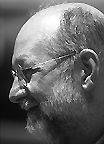


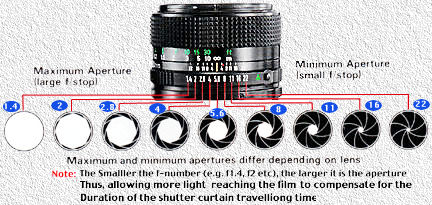
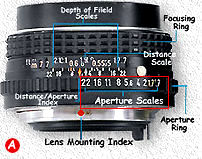
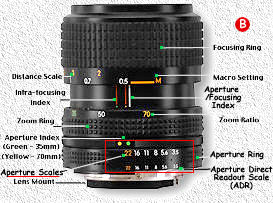
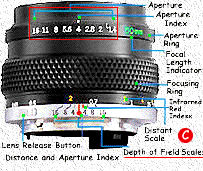
| Aperture value(s): | f/64, f/32, f/22, f/16, f/11, f/8.0, f/5.6, f/4.0, f/2.8, f/2.0, f/1.8/f1.4 etc. | Control via the lens section |
| Shutter speed(s): | 1/8000, 1/4000, 1/2000, 1/1000, 1/500, 1/250, 1/125, 1/60, 1/30, 1/15, 1/8, 1/4, 1/2, 1 sec, etc. | Control via the Camera section |
There are a few elements that will affects Depth of Field in a picture
(Note:- Factors on lens ONLY, shutter speed never affects depth of field):
| 1 | the lens opening (diaphragm inside the lens) | the bigger the apertures used, the zone of sharpness is shallower or vice versa i.e. smaller aperture used will has extended depth of field | |
| 2 | the focal length of the lens (50mm as standard, 80mm above as telephoto; 35mm or shorter as wideangle) | wide angle lenses have extended field of sharpness than a longer focal length telephoto lenses and/or longest reach focal length on your zoom lens), and | |
| 3 | the distance from the lens to the subject | the nearer the subject is, the shallower the zone of sharpness and vice versa. |


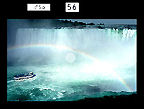
In fact, if you still don't understand, just memorize this: Other than it can be used to regulate amount of light entering into camera for an exposure, aperture also will affect the degree of depth of field. When combined with other essential elements that may also contribute to depth of field changes, such as focal length of the lens in use, the distance of your object in focus, you can make use of depth of field for creative control in your photography. For example: use larger aperture (Smaller number like f/2.8, f/2.0 etc.) with a long focal length to isolate or emphasis on expression, such as in portraiture photography; or use a smaller aperture (Bigger number like f/16 or f/22 etc..) to ensure pin-sharp details in both the foreground and the background.
Another factor you need to know is: All the markings on the lens barrel are double in effect . i.e. f/11 doubles the amount of light of f16, f2 allows 1X more light than of f2.8 does into the camera etc.
With a mechanical SLR camera, with the proper exposure GUIDE suggested by the built-in meter in a camera, you need to adjust both aperture and shutter speed yourself (it is termed as "MANUAL" setting in an automatic camera). Usually in the case of an automatic camera, you will still have manual control operating as if you are using a mechanical camera. Typically, a few extra choices of exposure control methods may be provided:- the first is called "Aperture Priority" (some camera uses a symbol "Av" - short for "aperture value"; the next is "Shutter Priority" (Tv - short for "Timing value". Aperture priority means you select the aperture to determine the depth of field yourself and the camera will set to the appropriate shutter speeds to match your aperture selected for a optimum exposure suggested by the camera's built-in electronic metering circuit, while shutter priority will let you select the preferred shutter speed setting and the camera will select the matching aperture values to match your choice. The third option is called the "Programmed Mode"(P - short for "Programmed Auto", where the camera select both the aperture value and the shutter speed for you and you may have no control in determine the depth of field yourself. (some cameras offer a another mode called flexi-program - I think it is too complicated to explain here).
|
|
|
|
| Top Av auto SLR models of yesterdays: -Other examples are: | Other examples like the Olympus OM2n and Canon AV-1 |
| The Shutter Speed ring of a MECHANICAL / NON-AUTO SLR. no Auto selection button or setting. You need to set the shutter speed on the camera section along with the aperture on the lens. Other brands such as Pentax offers K1000, Olympus has an OM-1 etc. |
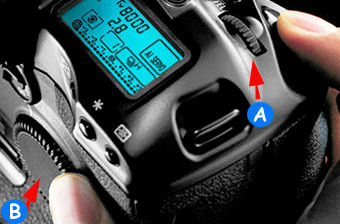 | Newer range of autofocus SLR cameras use a new method of controlling aperture. You will find there is NO NEED to set aperture via the lens aperture ring; instead - aperture is controlled by the thumb wheel for BOTH shutter Speed (B) and Aperture (A). A method first pioneered by Canon on their manual focus Camera, the Canon T90 back in 1986. Although this new electronic input method is different from older SLR cameras, the principle remains the same. The VISIBLE confirmation of the selected aperture used on camera like this type is via the LCD on the top panel OR through the viewfinder. |
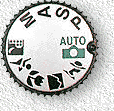
Note: An exposure control ring found in many modern SLR. The various setting may be represented by a few symbols/letters, "P" is for "Programmed AE", the "Tv" is for shutter priority while the Av (aperture value) is referring to aperture priority - Canon's way of interpreting in their A and T series camera bodies. IF you are a owner of one of those SLR cameras, you can find out the exact model you are using. While Nikon Owner may use THIS SECTION OR you may find the specific camera models that I might have developed with a featured section.
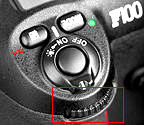
Every camera manufacturers have different design of how to adjust shutter speeds with a dedicated AF lens. For an example, Nikon's Nikon F5, 1996/7 finally followed Canon's path in using wheel input for shutter speed and aperture control; followed by its next generation AF film/digital-based SLRs which resulted in newer AF G-series Nikkor lenses now has NO aperture ring on the lens barrel for controlling aperture. However, if an older manual focus Ai lens is used in manual or aperture priority AE mode, it will still operate as an conventional SLR in which you will still make use of the lens aperture scales. Time changes, methods alter but basic principle remains.
| 歡迎光臨 公仔箱論壇 (http://os.tvboxnow.com/) | Powered by Discuz! 7.0.0 |